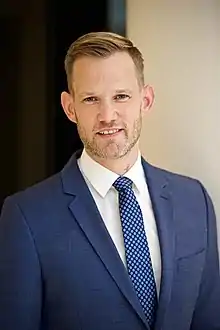COVID-19 Case-Cluster-Study
The COVID-19 Case-Cluster-Study – colloquially, Heinsberg study, also known as Heinsbergprotokoll and HEINSBERG PROTOKOLL. – is a study [1] about the COVID-19 pandemic in Gangelt.

The study was commissioned and is co-financed by the government of North Rhine-Westphalia and is led by Hendrik Streeck. In the public sphere, the marketing agency StoryMachine presented its results on Facebook and Twitter. Private enterprises also co-financed the study. The results of the study garnered cross-national media attention.[2]
The study aimed to determine lethality of and immunity to SARS-CoV-2; it also estimated the number of unrecorded cases.[3]
Despite the fact that sample size does not determine the representativeness of a study,[4] principal investigator Streeck claims, they examined more persons than recommended by the World Health Organization, the study would "thus be statistically absolutely representative".[5][6]
Criticism
One weakness of the study was the calculation of the IFR, which represents the lethality of COVID-19. The number of deaths were counted only for a period of 14 days. Because deaths accumulate over many weeks rather than directly after the infection, the study captured barely half the related deaths. This alone meant that the IFR was almost twice as high as calculated. When the study was published in Nature Communications in November 2020, the authors had not revised their calculation.[7]
References
- Streeck, Hendrik; Schulte, Bianca; Kümmerer, Beate M.; Richter, Enrico; Höller, Tobias; Fuhrmann, Christine; Bartok, Eva; Dolscheid, Ramona; Berger, Moritz; Wessendorf, Lukas; Eschbach-Bludau, Monika; Kellings, Angelika; Schwaiger, Astrid; Coenen, Martin; Hoffmann, Per; Stoffel-Wagner, Birgit; Nöthen, Markus M.; Eis-Hübinger, Anna-Maria; Exner, Martin; Schmithausen, Ricarda Maria; Schmid, Matthias; Hartmann, Gunther (2020). "Hendrik Streeck, Bianca Schulte, Beate Kuemmerer et al.: Infection fatality rate of SARS-CoV-2 infection in a German community with a super-spreading event". medRxiv 10.1101/2020.05.04.20090076v2.
- Sydney, Philip Oltermann Helen Davidson in; Orleans, Oliver Laughland in New; Bangkok, Rebecca Ratcliffe in; Paris, Joanna Walters in New York Kim Willsher in; Palermo, Lorenzo Tondo in (2020-04-09). "The cluster effect: how social gatherings were rocket fuel for coronavirus". The Guardian. ISSN 0261-3077. Retrieved 2020-04-15.
- Burger, Reiner (2020-03-27). "Ergebnisse ab nächster Woche: Am Beispiel von Heinsberg die Pandemie verstehen". Frankfurter Allgemeine Zeitung. ISSN 0174-4909. Retrieved 2020-04-16.
- Kaplan, Robert M.; Chambers, David A.; Glasgow, Russell E. (August 2014). "Big Data and Large Sample Size: A Cautionary Note on the Potential for Bias". Clinical and Translational Science. 7 (4): 342–346. doi:10.1111/cts.12178. ISSN 1752-8054. PMC 5439816. PMID 25043853.
- Matthias Jauch (2020-04-12). "Die Veröffentlichung zu Heinsberg war nicht leichtfertig" (Tagesspiegel). Der Tagesspiegel Online. Retrieved 2020-04-16. original text: "also statistisch absolut repräsentativ"
- Schneider, Paula (2020-04-15). "Unwissenschaftlich: Statistikerin zerlegt Heinsberg-Studie, auf die sich Laschet stützt". Focus. Retrieved 2020-04-18.
- "Neuer Wirbel um Streecks Heinsberg-Studie". ntv. 27 November 2020. Retrieved 15 December 2020.